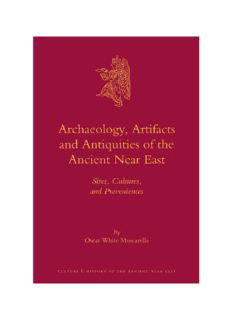Table Of ContentArchaeology, Artifacts and
Antiquities of the Ancient Near East
Culture and History of the
Ancient Near East
FoundingEditor
M.H.E.Weippert
Editor-in-Chief
ThomasSchneider
Editors
EckartFrahm(YaleUniversity)
W.RandallGarr(UniversityofCalifornia,SantaBarbara)
B.Halpern(PennsylvaniaStateUniversity)
TheoP.J.vandenHout(OrientalInstitute)
IreneJ.Winter(HarvardUniversity)
VOLUME62
Thetitlespublishedinthisseriesarelistedatbrill.com/chan
Archaeology, Artifacts and
Antiquities of the Ancient Near East
Sites, Cultures, and Proveniences
By
OscarWhiteMuscarella
LEIDEN•BOSTON
2013
LibraryofCongressCataloging-in-PublicationData
Muscarella,OscarWhite.
Archaeology,artifactsandantiquitiesoftheancientNearEast:sites,cultures,andproveniences/
byOscarWhiteMuscarella.
p.cm.
ISBN978-90-04-23666-0(hardback:alk.paper)–ISBN978-90-04-23669-1(e-book)1.Middle
East–Antiquities.2.Excavations(Archaeology)–MiddleEast.3.MiddleEast–Civilization–To622.4.
Iran–Antiquities.5.Excavations(Archaeology)–Iran.6.Turkey–Antiquities.7.Excavations
(Archaeology)–Turkey–Gordion(Extinctcity)8.Forgeryofantiquities.I.Title.
DS56.M8482013
939.4–dc23
2013006440
Thispublicationhasbeentypesetinthemultilingual“Brill”typeface.Withover5,100
characterscoveringLatin,IPA,Greek,andCyrillic,thistypefaceisespeciallysuitablefor
useinthehumanities.Formoreinformation,pleaseseewww.brill.com/brill-typeface.
ISSN1566-2055
ISBN978-90-04-23666-0(hardback)
ISBN978-90-04-23669-1(e-book)
Copyright2013byKoninklijkeBrillNV,Leiden,TheNetherlands.
KoninklijkeBrillNVincorporatestheimprintsBrill,GlobalOriental,HoteiPublishing,
IDCPublishersandMartinusNijhoffPublishers.
Allrightsreserved.Nopartofthispublicationmaybereproduced,translated,storedin
aretrievalsystem,ortransmittedinanyformorbyanymeans,electronic,mechanical,
photocopying,recordingorotherwise,withoutpriorwrittenpermissionfromthepublisher.
AuthorizationtophotocopyitemsforinternalorpersonaluseisgrantedbyKoninklijkeBrillNV
providedthattheappropriatefeesarepaiddirectlytoTheCopyrightClearanceCenter,
222RosewoodDrive,Suite910,Danvers,MA01923,USA.
Feesaresubjecttochange.
Thisbookisprintedonacid-freepaper.
CONTENTS
Introduction............................................................ 1
PARTONE
SITESANDEXCAVATIONS
SectionOne.Iran
1. TheTumuliatSéGirdan:APreliminaryReport .................... 9
2. TheTumuliatSéGirdan:SecondReport........................... 43
3. TheChronologyandCultureofSéGirdan:PhaseIII ............... 83
4. Qalatgah:AnUrartianSiteinNorthwesternIran................... 97
5. ExcavationsatAgrabTepe,Iran .................................... 109
6. TheIronAgeatDinkhaTepe,Iran.................................. 161
7. WarfareatHasanluintheLate9thCenturybc..................... 255
8. TheHasanluLionPinsAgain....................................... 285
9. TheExcavationofHasanlu:AnArchaeologicalEvaluation......... 305
10. TheIranianIronIIIChronologyatMuweilahintheEmirateof
Sharjah ............................................................. 351
11. TheLocationofUlhuandUisˇeinSargonII’sEighthCampaign,
714bc............................................................... 369
12. SurkhDumatTheMetropolitanMuseumofArt:AMini-Report... 389
13. North-WesternIran:BronzeAgetoIronAge ....................... 459
14. Jiroftand“Jiroft-Aratta”:AReviewArticleofYousefMadjidzadeh,
Jiroft:TheEarliestOrientalCivilization.............................. 485
15. SargonII’s8thCampaign:AnIntroductionandOverview.......... 523
SectionTwo.Anatolia
16. KingMidas’TumulusatGordion................................... 533
17. TheIronAgeBackgroundtotheFormationofthePhrygianState.. 549
18. TheDateoftheDestructionoftheEarlyPhrygianPeriodat
Gordion ............................................................ 569
19. AgainGordion’sEarlyPhrygianDestructionDate:ca.700+/-bc... 601
20. UrartianMetalArtifacts:AnArchaeologicalReview ............... 621
vi contents
PARTTWO
ARTIFACTS,CULTURES,FORGERIES,ANDPROVENIENCE
SectionOne.TheAegeanandtheAncientNearEast
21. TheArchaeologicalEvidenceforRelationsbetweenGreeceand
IranintheFirstMillenniumbc..................................... 655
22. UrartianBellsandSamos........................................... 689
23. KingMidasofPhrygiaandtheGreeks.............................. 703
24. GreekandOrientalCauldronAttachments:AReview ............. 725
SectionTwo.Artifacts
25. FibulaeRepresentedonSculpture.................................. 767
26. PhrygianorLydian? ................................................ 783
27. FibulaeandChronology,MarlikandAssur......................... 803
28. ParasolsintheAncientNearEast .................................. 817
SectionThree.TheAntiquitiesMarketandthePlunderCulture
29. ThePopeandtheBitterFanatic .................................... 827
30. TheAntiquitiesTradeandtheDestructionofAncientNear
EasternCultures.................................................... 837
31. TheFifthColumnwithintheArchaeologicalRealm:TheGreat
Divide .............................................................. 861
SectionFour.Forgeries
32. BazaarArchaeology ................................................ 879
33. ExcavatedintheBazaar:Ashurbanipal’sBeaker.................... 889
34. VonBissing’sMemphisStela:AProductofCulturalTransfer? ...... 901
35. GudeaornotGudeainNewYorkandDetroit:Ancientor
Modern?............................................................ 915
36. TheVeracityof“Scientific”TestingbyConservators................ 931
SectionFive.ForgeriesofArchaeologicalProvenience
37. “Ziwiye”andZiwiye:TheForgeryofaProvenience................. 955
38. MedianArtandMedizingScholarship ............................. 999
39. MuseumConstructionsoftheOxusTreasures:Forgeriesof
ProvenienceandAncientCulture ..................................1025
40. ExcavatedandUnexcavatedAchaemenianArt.....................1043
INTRODUCTION
When asked by Jennifer Pavelko of Brill USA to compile a volume of my
pastarticles,onthemodelofthetwovolumesofIreneWinter’soutstand-
ingscholarshippublishedbyBrill,Iwasofcourseflattered.Andthenbegan
thedifficulttaskofdecisionmaking.Giventhelimitationofapproximately
forty articles to be selected by me, I had first to examine my curriculum
vitaandmakealistofwhichtochoose.WhenIreachedfiftyarticlesIwas
obliged to refocus my mind and eliminate ten of them. This exercise was
fortunate,Ibelieve,foritforcedmenotmerelytofocusonworksthattomy
mindreflectadiachroniccompendiumofmydecadesofwriting,butcon-
comitantly,andasobjectivelyaspossible,tocontemplatetheverynature
andthrustsofmyworkasawhole.Thescopeofmyresearchandwriting
haswidenedfromthe“pure”archaeologicalworkofexcavationreportsand
artifactanalysestoincludeasharpenedinterestinthevastnumberofunex-
cavatedantiquities—and,asIcametorealize,offorgeries—aswellasasso-
ciatedculturalphenomenathatoftenruncontrarytoarchaeologicalgoals.
InthisintroductionIpresentmyacademicandintellectualbackgroundasa
wayofexplaininghowmyinterestsmultipliedanddeveloped.Ivigorously
insist that although to some the subjects of artifact analysis, forgery, and
provenancemightappeartobediverse,theyaretothecontrarynotdiscrete
subsetsofarchaeologicaldiscourse;theycollectivelyformequalcomponents
ofthecoreofarchaeologicalresearchandconclusion-formation.
I readily identify myself as an archaeologist, one concerned with the
materialandhistoricalculturesoftheancientNearEast,primarilythoseof
ancient Iran and Anatolia; I do not further identify myself as a specialist,
suchasananthropologistorarthistorian,inasmuchasIseetheiractivities
asinherentinarchaeologicalresearch.OvertimeIcametotheconclusion
thatwhatsomecallarthistoryisinfacttheanalysisandculturalevaluation
ofartifacts,i.e.,normalarchaeologicalactivity.Idiscoveredquitesoon(in
the1960s)thatmanyarchaeologistsIencounteredhadlittleknowledgeof
artifactsingeneral(except,ofcourse,pottery)andcouldnotidentifythem
orunderstandtheirmanifestculturalandchronologicalvalue.AtHasanlu
when studying what we excavated I was teased by being called “object-
oriented.”Theseinteractionsonlyreinforcedmyopinionoftheimportance
ofartifactanalysisintheworkofarchaeology,asmyarticlesandbooksmake
clear.
2 introduction
MycareerasanarchaeologistbeganwithmyinterestinEgyptianarchae-
ology,determinedbymyreadingofBreastedandPetriewhileIwasastudent
atStuyvesantHighSchoolinNewYorkCity.1IthenattendedtheCityCol-
legeofNewYork,majoringinhistory(primarilymodernhistory)because
noarchaeologycourseswereinthecurriculum.2WhileatCCNY,duringthe
summerIexcavatedattwositesintheUnitedStates,thePueblositeatMesa
VerdeinColorado(1953)andaMandansite,SwanCreekinSouthDakota
(1955). At Swan Creek I received notice that I had been awarded a schol-
arship(includingastipendof$57.50amonth,withoutwhichIcouldnot
haveacceptedthescholarship)inclassicalarchaeologyattheUniversityof
Pennsylvania. I had first applied to study Egyptian archaeology but I was
rejectedforthisendeavor;whenaskedtochooseanothercourse,Ireplied,
“Archaeology.” I, whothen had no Greek,little German, and no academic
archaeological background, was accepted by Rodney S. Young as his stu-
dent.Henevertoldmehisreasonsforacceptingmebutitwasamiraculous
gift, for my life was utterly altered. Young was one of the most extraordi-
naryandintelligentarchaeologists(andhumanbeings)Ihaveeverencoun-
tered.
In1957Youngtookmeand(generously,indeed!)mywifeGrace,whomI
hadrecentlymarried,toGordionforfivemonths.3HereIexperiencedtwo
significantemotionalandintellectualevents:livingandworkingwithwon-
derful,friendlyTurkishvillagersinYassihüyük,andthemonths-longexca-
vationofTumulusMM,aburialenclosurefilledwithsumptuousartifacts,
builtandfurnishedbyKingMidasforhisfatherGordias.Buttherewasmore,
foritwasherethatImetmyfirstfibula,infactagroupofthemfastening
theclothingofKingGordias.Itwasacerebraldiscoverythatneverleftme,
forthoseartifacts,alongwiththesocketedarrowheadsIlaterencountered,
servedmeandothersovertheyearsasacriticalLeitmotivandplayedakey
roleindeterminingpostquemchronologies.Gordionremainedmyarchae-
ologicalhome,sotospeak,anditwasherethatIreturnedinthesummerof
1959,leavingtheAmericanSchoolofClassicalArchaeologyinAthens,where
IwasspendingayearasaFulbrightscholar.Iwasnotallowedtodiginthe
1 TheworksIreadincludedJamesHenryBreasted,AHistoryofEgypt(2nded.;NewYork:
CharlesScribner,1924),andW.M.FlindersPetrie,TheReligionofAncientEgypt (London:
A.Constable&Co.,1906),amongothers.
2 IattendedtheeveningsessionbecauseIhadtoearnmylivinginthedaytime.
3 GraceeventuallyworkedwithPietdeJongandbecamehisassistantaswellasafellow
archaeologicalartist.
introduction 3
Agorabecauseofunbearableclasssnobberyandwenteast.Giventhedif-
ferencesinthesetwoencounters,itisnowonderthatIchosetoremainin
theworldofancientNearEasternarchaeologyinsteadofclassical.
My firstengagement withIranian archaeologycame in1960, theyear I
finishedmycourseworkinclassicalarchaeologywithYoungandwashired
toteachhistoryatCCNY,beginninginthefall.SolelybecauseofmyGordion
background(IhadtakenonlyonecourseinancientNearEasternarchaeol-
ogyatPenn),RobertH.DysonJr.invitedmetocometoHasanlu,innorth-
westernIran,forwhichdeedIamindebtedtohim.ThereafterIexcavatedat
HasanluandeightotherIranianandAnatoliansites,andthroughthiswork
IbecameanancientNearEasternarchaeologist.Mydoctoraldissertation
(finalizedin1965andpublishedin1967)wasofcourseonPhrygianfibulae,
myfirstartifactuallove.In1964IleftCCNYforapositionintheDepartment
of Ancient Near Eastern Art at the Metropolitan Museum of Art (MMA),
whichIleftuponmyretirementin2009.
In my early years at the MMA I continued to excavate and to publish
articlesderivedfromthoseactivities.Butafterafewyearsofworkingcon-
tinuously with purchased antiquities in the museum, I began to realize
that something was utterly wrong regarding the nature of how scholars
in the discipline, both at the museum and in academia, published antiq-
uities. The very first time I empirically learned about plundering and its
attendantdestructionofancientsiteswasintheearly1970s,whenIheard
lecturesbytheHarvardMesoamericanscholarClemencyCogginsandthe
IranianarchaeologistEzatNegahbanonthismajorbutformehithertofully
neglectedissue.Ifirstthennoticedthatnotonlymymuseumcolleaguesbut
manyothersfailedtomaketheobviousandnecessarydistinctionbetween
an excavated artifact and a purchased antiquity acquired from collectors,
antiquitydealers,ortheauctionhousesubiquitousinEurope,theUnited
States,andinmodernNearEasterncountries.Ialsolearnedthatthisactiv-
itywasinfactaworldwideculturalproblem.MymindstumbledbutIsoon
came into contact with a few other similarly minded colleagues, mainly
JamesWisemanofBostonUniversityandRossHollowayofBrownUniver-
sity.In1973weformedanewarchaeologicalgroup,theAssociationofField
Archaeologists,andsoonthereafterwebegantopublishTheJournalofField
Archaeology(mashallah,stillinexistence)throughBostonUniversity.The
battle had begun, and it has not ceased. My first article on plunder and
theroleofmuseumtrustees,officers,andcuratorsaswellasprivatecollec-
torsinthedestructionofthisplanet’shistoryappearedintheJFA(1/2,1974:
221–222), and the publications have continued nonstop; my most recent
appearedin2012.
Description:'Archaeology, Artifacts and Antiquities of the Ancient Near East' follows the evolution of the author’s scholarly work and interests and is divided into several categories of interrelated fields. The first part deals primarily with excavations and associated artifacts, issues in ancient geography

